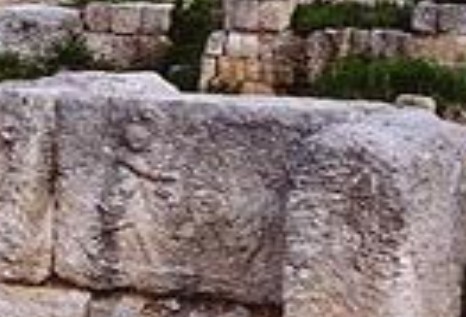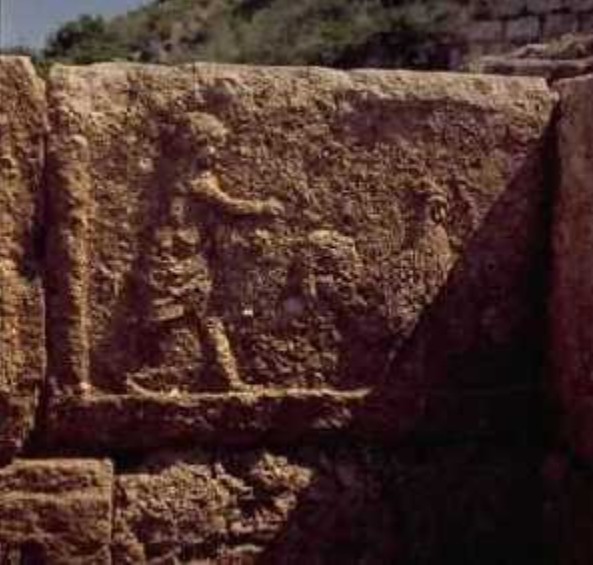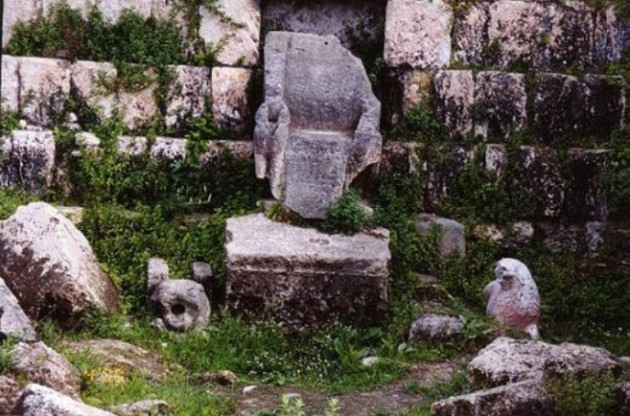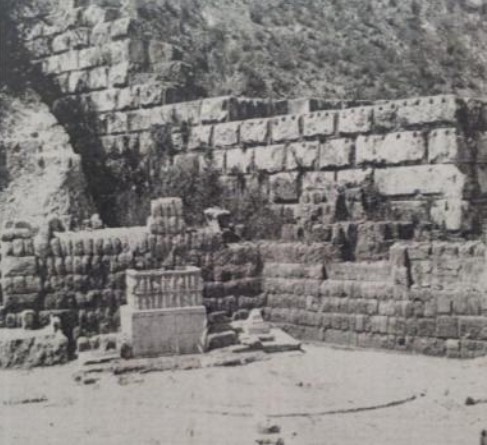The temple of Eshmun near Sidon
The building with the Children friezes
This building consists of an outdoor courtyard, some shrines and store-rooms for cult objects, offerings, votive sculptures (intended to thank the gods for their favours). The purpose of the edifice is not clear. It may have served as housing for the priesthood, as a cultic structure, or a space dedicated to medical treatment or even meeting rooms for religious or staff fellowships (Thiasos or koinon) or more mundanely as a warehouse or the seat of trade or crafts guilds. A frieze sculpted in local stone evokes a hunting procession connoting Eshmun's legend, children games illustrating the god's powers, and ritual scenes. One block shows a young boy with a loin wrap looping his left arm, and whose hand holds some jacks or glass trinkets trying to catch a rooster. This scene refers to the practice according to which the sick sacrificed a rooster, symbolising a new dawn, to Eshmun-Asklepios. Thus Socrates[1] last words acknowledged his debt of “a cock to Asklepios” who at that moment had released him from earthly life.



The empty throne of Astarte
At the foot of the temple and backed against lie the remains of a sanctuary dedicated to Astarte. This lower temple consists of a paved pool in a square room where an “empty throne of Astarte” operates as the cult statue. Carved from a single granite bloc, it is set in a niche in the far wall of the shrine, below the frieze. It is flanked by two sphinxes decorated with a pharaonic style moulding and placed between two sculpted lions. Astarte is linked to a new type of iconography. She is represented devoid of human features. Her presence is restricted to an empty seat with sphinx-shaped arm-rests. This empty throne is, much as a baetylus[2] would, the object of veneration. In order to heal and obtain mercy from Baal, Astarte and Eshmun, believers came to bathe in the sacred water of the throne room pool. This pool lost its role in the course of the 2nd century AD when it was filled up with earth and broken artefacts. Hard by the temple, an array of pools with a ritual purpose are also fed by the Ydll spring.

“Temple-boys”
This temple houses many votive statues bearing the names of the worshipers. An inscription found on a plinth completed at the end of the 5th century BC indicates that the statues and access to the place were monitored by specified individuals. Athletic bodies hint at Olympiad victors come to thank Astarte. The influence of the Greek archaic period[3] is plain. The Phoenician input translates into heavy, wavy hairdos, the elongated eyes are Egyptian, the straight nose and the broad smile is reminiscent of the Kouros[4] though the body is here wearing clothes. Alongside them, perhaps in reference to Eshmun's role as healer of children, countless full scale statues show boys between the ages of 1 and 5 (only two little girls have been recorded). Naked for the most part, standing, sitting or crouching on a plinth, some play with an animal or a toy. Another work dating to the 4th century BC represents a shaven-headed boy, bare-chested with the lower part of his body draped over who holds a pigeon in his right hand (a recurrent theme in Phoenicia) whilst his left hand rests on a tortoise, symbol of longevity, wisdom and prudence. The Phoenician inscription from Baal Shillem seeking the god Eshmun's blessing confirms the healing and regal aspects of this temple.

 Informations[5]
Informations[5]Around the temple-boy, 3000 non moulded drop-shaped glass beads have been found. These glass trinkets, that have no equivalent elsewhere, were intended to amuse the children presented at the temple. Ten or so urns, some anepigraphic some inscribed in Greek, carved out of solid roc may be linked to the life of the holy site: According to Dunand, they stand for the baetylus of Sidonian Astarte. The last cult site is a shrine below the podium. Hygieia occupies a sacred hidden cippus[6]. Upright in a pleated tunic draped over her left arm, she carries a cup which may have held a stone egg, potentially a cure. A snake, symbol of purification and carefulness coiled around her other arm, makes for the cup in what would become the emblem of pharmacists. Lastly of interest is a damaged stone dating to the 2nd century and referring to the Esklapios of Sidon. It suggests the presence of a cult to the goddess Panakeia, daughter of Esklapios and that her statue probably stood somewhere in the precinct of the temple of Eshmun Esklapios.

The “tribune”
Achieved in Attic Greek style[8], a tribune or so-called tribune was sculpted c. 350 BC, a troubled period in Sidon's history. It was found near a cippus, a plinth and a throne of Astarte, which confirm its cultic dimension. The throne bears out an ongoing Phoenician cult, the Greek cultural input notwithstanding. Its arm-rests are adorned with winged sphinxes. Its carved back shows a goddess draped in a long tunic sitting on a throne flanked by two quadrupeds. At each end, two columns are embossed with medallions of hathoric heads. The tribune offers three visible sides, clad with marble plates held together and to the stonework with bronze clamps. It is decorated by two superimposed registers of high-relief frieze of equal height and symmetrical composition. The upper register of the main elevation shows an assembly of Greek divinities with at the centre the Greek god Apollo playing the zither with at his side the goddess Athena[9] holding her helmet. The lower register shows people dancing to the sound of the zither and the flute and a satyre[10] lead on by a maenad. This iconography raises questions as to what can be attributed to Greek cult and what to Phoenician cult. Specialists have put forward diverse interpretations that sometimes contradict each other and no discovery has come to settle the matter.

 Informations[11]
Informations[11]
 Informations[13]
Informations[13]The absence of tombs around the temple vouches for the fact that the cult of Eshmun was not linked to death. This cult disappeared with the construction of a Byzantine church. A “tomb of Eshmun” (Qabr Shmoun) has been located near Beirut whilst in Sidon the waters continued to draw the crowds until the beginning of the Muslim Era. Thereafter, a large part of the temple would vanish at the hand of time, the re-use of its materials for other constructions (in the 17th century, Fakhr al-Din[14] had a bridge built on the Awali River with stone from what was at the time considered a quarry), theft, wars (including those of 1975-90) and wilful destructions sometimes on religious grounds.







